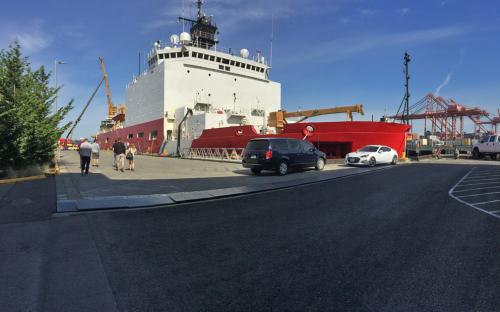GO DEEPER DISCUSSION: (see previous journal for the questions.)
In the time-lapse video’s second scene, you’ll notice the Healy first seem to sink a bit, and then rise back up substantially. The motion isn’t due to the ship changing its buoyancy but rather from the changing tide. It turns out that the new moon was on June 16, right in the middle of our loading session. New moons create the largest changes in sea level, as the Moon & Sun are both on the same side of the Earth and their gravity combines to create the largest effects on sea level. These are known as spring tides. I made a new video showing another vantage of the tide changing in the first scene and a very sped-up version of the loading time lapse from yesterday in the second scene of this movie. Both compress 6 or 7 hours into just a few seconds, which really makes the motion apparent. It is impressive to consider the power needed to lift a 16,000-ton ship like the Healy but the tides effortlessly do so twice a day, every day! (For best effect, click on the YouTube icon in the lower right and then view in full screen.)
TODAY'S JOURNAL:
A significant part of any scientific expedition such as the 2015 US Arctic GEOTRACES cruise is planning. Every science team involved in the cruise has to figure out the equipment they will need as well as how to deploy and operate it in the unique environment of a polar-capable icebreaker, its small boats, and on the ice itself. From larger teams at home, a limited number of participants are tapped to sail as the Healy only has room for 50 scientists. Once Healy sails, there are no trips to the home lab supply cabinets or local hardware store, so in addition to the working gear needed each team has to consider what backups, replacements, and repair parts should be brought along.
Since I’m not a member of any of the research groups, I didn’t have to worry about much of the planning aspects of the cruise. I did try to get most of my personal gear together and bring it with me to the Healy at its home base in Seattle, as luggage is notoriously slow to reach Dutch Harbor in the Aleutian Islands where we will commence our cruise on 9 August. So I headed out with a fully-wedged, 49.9-lb suitcase to lend a hand at the loading phase in Seattle 15-18 June. My bag there was joined with literally tons of science gear, personal gear, and science vans (more on these later) to be loaded and then stowed or set up prior to the Healy heading off for its 2015 Arctic Season.

There is a good reason to do this at Healy’s home port of Seattle, even though it means getting stuff ready and onboard over a month and a half before the actual cruise. Shipping truckfuls of gear to the Aleutian Islands would take much longer, cost much more, and would be less reliable. So this phase of the expedition stands apart from the final deployment of gear in Dutch Harbor and the 2-month (or so) cruise itself.




Loading the ship felt to me what it must be like in a beehive- to say it was a busy few days would be an understatement. On my most active day I logged almost 17,000 steps, or about 7.7 miles on my FitBit. I mainly helped with Dr. William Landing’s group, as he is the PolarTREC researcher I’m partnered with. Dr. Landing is a co-chief scientist on the cruise and will be conducting aerosol sampling research along with two post-doctoral fellows (stay tuned for lots more on these folks and their studies later!) The big task we had in Seattle was to get the aerosol sampling gear aboard and in place. The ship’s 04 level starboard crane could lift the equipment from the wharf up to the area behind the smoke stack 4 levels up from the main deck, and from there we unloaded and carried it up two more levels to the flying bridge, which is the open space on the roof over the bridge almost 80 feet above the water line. There we rigged up the samplers and secured them to the rail, where they will hopefully be waiting for their final testing and use in the Arctic! Again, stay tuned for lots more about aerosol sampling and all of the other awesome science going on during our cruise!
Hosting the aerosol sampling gear to the 04 level, hand-carrying it two more levels up to the flying bridge.
Details of the aerosol sampler set-up process.
GO DEEPER!
You’ll notice a pair of stadiums in the background of some of the video clips. Try using Google Earth to search for the US Coast Guard Base Seattle, and then virtually fly around a bit to figure out what stadiums they are and what teams play in each!
That's all for now. Best- Bill


Comments